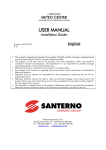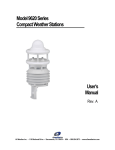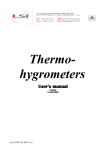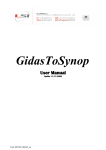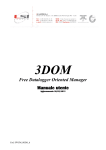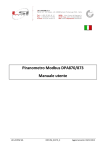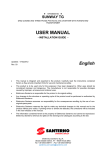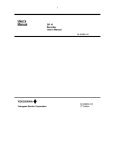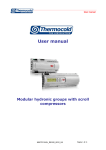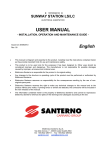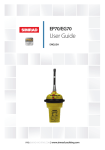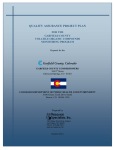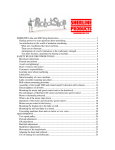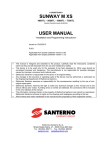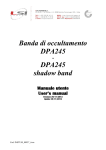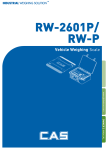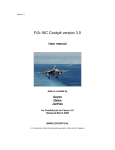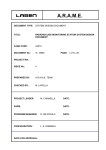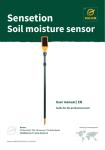Download USER MANUAL
Transcript
• 15P0061B200 • METEO CENTER PLUS WEATHER DATA ACQUISITION SYSTEM USER MANUAL Issued on 10/01/2013 R. 00 English • This manual is integrant and essential to the product. Carefully read the instructions contained herein as they provide important hints for use and maintenance safety. • This product is to be used only for the purposes it has been designed to. Other uses should be considered improper and dangerous. The manufacturer is not responsible for possible damages caused by improper, erroneous and irrational uses. • Elettronica Santerno is responsible for the product in its original setting. • Any changes to the structure or operating cycle of the product must be performed or authorized by Elettronica Santerno. • Elettronica Santerno assumes no responsibility for the consequences resulting by the use of nonoriginal spare-parts. • Elettronica Santerno reserves the right to make any technical changes to this manual and to the product without prior notice. If printing errors or similar are detected, the corrections will be included in the new releases of the manual. • The information contained herein is the property of Elettronica Santerno and cannot be reproduced. Elettronica Santerno enforces its rights on the drawings and catalogues according to the law. Elettronica Santerno S.p.A. Strada Statale Selice, 47 - 40026 Imola (BO) Italy Tel. +39 0542 489711 - Fax +39 0542 489722 santerno.com [email protected] METEO CENTER PLUS USER MANUAL Table of Contents 1. GENERAL INFORMATION ON THE PRODUCT ......................................................6 1.1. COMPONENTS OF THE METEO CENTER PLUS .................................................. 8 1.2. MAIN STANDARD FUNCTIONS .............................................................................. 9 1.3. SCOPE OF THIS MANUAL ...................................................................................... 9 1.4. FOR WHOM THIS MANUAL IS INTENDED ............................................................ 9 1.5. ATTACHED DOCUMENTATION ............................................................................. 9 1.5.1. PRESERVATION OF THE DOCUMENTATION ............................................................ 9 1.6. SYMBOLS USED ................................................................................................... 10 1.7. DEFINITIONS ........................................................................................................ 10 2. CAUTION STATEMENTS .......................................................................................11 2.1. INTENDED USE .................................................................................................... 11 2.2. QUALIFIED TECHNICAL PERSONNEL ................................................................ 11 3. PRODUCT IDENTIFICATION .................................................................................12 3.1. DELIVERY CHECK ................................................................................................ 12 3.2. PRODUCT ID CODE ............................................................................................. 12 3.3. SERIAL NUMBER .................................................................................................. 12 4. PRODUCT CONFIGURATION ................................................................................13 4.1. E-LOG DATALOGGER .......................................................................................... 13 4.2. SENSORS ............................................................................................................. 13 4.3. AIR TEMPERATURE SENSOR ............................................................................. 14 4.3.1. WIND SPEED AND WIND DIRECTION SENSOR ...................................................... 14 4.3.2. SECOND CLASS PYRANOMETER ............................................................................ 15 4.3.3. SOLAR CELL RADIOMETER ...................................................................................... 15 4.3.4. CONTACT TEMPERATURE SENSOR ....................................................................... 16 4.3.5. THERMOHYGROMETRIC SENSOR .......................................................................... 16 4.4. POLE AND TIE RODS ........................................................................................... 17 4.5. SERIAL PORTS ..................................................................................................... 17 4.6. STANDARD ONBOARD CONFIGURATION .......................................................... 17 5. HANDLING AND PLACEMENT...............................................................................19 5.1. ENVIRONMENTAL REQUIREMENTS FOR STORAGE AND TRANSPORT ......... 19 5.2. INSTALLATION PLACE ......................................................................................... 19 5.3. PLACING THE SENSORS ..................................................................................... 19 6. MOUNTING, INSTALLATION AND COMMISSIONING ..........................................20 6.1. INSTALLING THE E-LOG DATALOGGER ............................................................ 20 6.1.1. 2/55 E-LOG POWER SUPPLY ............................................................................................ 20 USER MANUAL METEO CENTER PLUS 6.2. INSTALLING THE SENSORS ................................................................................ 21 6.2.1. AIR TEMPERATURE SENSOR ................................................................................... 21 6.2.1. WIND DIRECTION AND WIND SPEED SENSOR ...................................................... 22 6.2.2. SOLAR RADIATION SENSORS .................................................................................. 22 6.2.3. CONTACT TEMPERATURE SENSOR ....................................................................... 23 6.3. CONNECTING THE SENSORS TO THE E-LOG................................................... 24 6.4. CONNECTING THE SERIAL CONVERTER TO THE COMMS PORT ................... 26 6.5. AUXILIARY POWER SUPPLY ............................................................................... 26 6.6. POWER ON ........................................................................................................... 26 7. COMMUNICATIONS AND REMOTE MONITORING ..............................................27 7.1. GENERAL INFORMATION .................................................................................... 27 7.2. COMMS PORTS AND PROTOCOLS USED.......................................................... 27 7.3. CONNECTION TOPOLOGIES............................................................................... 28 7.4. CONNECTION ....................................................................................................... 29 7.5. MODBUS MAP ....................................................................................................... 30 8. HOW TO USE THE DATALOGGER .......................................................................31 8.1. USING THE KEYPAD ............................................................................................ 31 8.2. INFORMATION ON THE DISPLAY ........................................................................ 32 8.2.1. MASK OF THE PRODUCT INFO ................................................................................ 32 8.2.2. INSTANT VALUES OF THE PROGRAMMED MEASURES ....................................... 32 8.2.3. DIAGNOSTIC INFO ..................................................................................................... 33 8.2.4. LEDS ........................................................................................................................ 36 9. MAINTENANCE ......................................................................................................37 9.1. MAINTENANCE SHEET ........................................................................................ 37 9.2. AIR TEMPERATURE SENSOR ............................................................................. 37 9.3. WIND SPEED AND WIND DIRECTION SENSOR ................................................. 38 9.4. STANDARD SECOND CLASS PYRANOMETER .................................................. 39 9.5. SOLAR CELL RADIOMETER ................................................................................ 39 9.6. CONTACT TEMPERATURE SENSOR .................................................................. 40 10. TROUBLESHOOTING ....................................................................................41 10.1. MALFUNCTION OF THE DATALOGGER AND/OR THE CONNECTED SENSORS41 10.1.1. MALFUNCTION INDICATED IN THE MEASURES..................................................... 42 10.2. MALFUNCTION OF THE COMMS PORTS............................................................ 42 10.2.1. SERIAL COMMUNICATIONS FAILURES ................................................................... 42 10.3. HOW TO CONTACT THE CUSTOMER SERVICE ................................................ 43 11. TECHNICAL DATA .........................................................................................43 11.1. NAMEPLATE ......................................................................................................... 43 11.2. TECHNICAL AND ELECTRICAL SPECIFICATIONS OF THE E-LOG DATALOGGER ...................................................................................................................... 44 11.3. TECHNICAL AND ELECTRICAL SPECIFICATIONS OF THE SENSORS ............. 46 3/55 METEO CENTER PLUS USER MANUAL 11.3.1. AIR TEMPERATURE SENSOR ................................................................................... 46 11.3.2. WIND DIRECTION AND WIND SPEED COMBINED SENSOR ................................. 47 11.3.3. STANDARD SECOND CLASS PYRANOMETER ....................................................... 48 11.3.4. SOLAR CELL RADIOMETER ...................................................................................... 49 11.3.5. CONTACT TEMPERATURE SENSOR ....................................................................... 50 11.3.6. THERMOHYGROMETRIC SENSOR .......................................................................... 51 12. 4/55 DECLARATIONS OF CONFORMITY .............................................................52 USER MANUAL METEO CENTER PLUS Index of Figures Figure 1: Meteo Center Plus, weather data acquisition system ..........................................................................6 Figure 2: Components of the Meteo Center Plus ...............................................................................................8 Figure 3: E-Log Datalogger...............................................................................................................................13 Figure 4: PT100 thermometer ..........................................................................................................................14 Figure 5: Wind speed and Wind direction combined sensor ............................................................................14 Figure 6: Second class pyranometer ................................................................................................................15 Figure 7: Solar cell radiometer ..........................................................................................................................15 Figure 8: Contact temperature sensor ..............................................................................................................16 Figure 9: Power supply connector ....................................................................................................................21 Figure 10: Installing the sensors .......................................................................................................................22 Figure 11: General wiring diagram ...................................................................................................................25 Figure 12: RS232-RS485 converter .................................................................................................................26 Figure 13: Multidrop connection diagram .........................................................................................................28 Figure 14: Front part of the E-Log datalogger ..................................................................................................31 Figure 15: LEDs ................................................................................................................................................36 Figure 16: Nameplate of the Meteo Center Plus ..............................................................................................43 Figure 17: Air temperature sensor ....................................................................................................................46 Figure 18: Wind direction and wind speed combined sensor ...........................................................................47 Figure 19: Standard Second Class Pyranometer .............................................................................................48 Figure 20: Photovoltaic Cell Radiometer ..........................................................................................................49 Figure 21: Contact temperature sensor ............................................................................................................50 Figure 22: Temperature and relative humidity sensor ......................................................................................51 Index of Tables Table 1: Documentation supplied with the product .............................................................................................9 Table 2: Technical specifications of the tie rods ...............................................................................................17 Table 3: Environmental requirements for storage and transport ......................................................................19 Table 4: E-log power supply .............................................................................................................................20 Table 5: Input-actuator matching ......................................................................................................................24 Table 6: Serial ports ..........................................................................................................................................27 Table 7: Connection cable for RS485 bus ........................................................................................................29 Table 8: Measures M001 to M020 at a glance .................................................................................................30 Table 9: Maintenance sheet .............................................................................................................................37 Table 10: Flashing mode of the red “Err” LED ..................................................................................................41 Table 11: Caratteristiche tecniche ed elettriche del E-LOG DATALOGGER ...................................................45 Table 12: Technical and electrical specifications of the temperature sensor ...................................................46 Table 13: Technical and electrical specifications of the antiradiation screen ...................................................46 Table 14: Technical and electrical features of the tacho-gonioanemometer ....................................................47 Table 15: Technical and electrical features of the pyranometer .......................................................................48 Table 16: Technical and electrical features of the photovoltaic cell radiometer ...............................................49 Table 17: Technical and electrical features of the contact temperature sensor ...............................................50 Table 18: Technical and electrical features of the thermohygrometric sensor (optional) .................................51 5/55 METEO CENTER PLUS USER MANUAL 1. GENERAL INFORMATION ON THE PRODUCT Figure 1: Meteo Center Plus, weather data acquisition system The Meteo Center Plus station is the top-quality solution enabling monitoring the environmental variables of a photovoltaic plant. Operators and investors in photovoltaic plants need to evaluate the proper operation of their systems with the highest precision. This is essential for monitoring the actual conversion efficiency and the presence of any failures or decays and, at the same time, for guaranteeing the investment and its payback time. Weather conditions are the main exogenous limitations to optimum performance of a plant: total radiation temperature values and wind conditions can adversely affect the plant efficiency. Monitoring the weather condition parameters with extreme accuracy is the only way for operators to check the proper operation of the plant in real time. As per solar radiation, which is the most important variable to be monitored, Elettronica Santerno recommends that pyranometers should be used to guarantee low feedback time, limited temperature effect, optimum spectral response and high stability over time, according to international technical regulations. Pyranometers guarantee that the overall measurement uncertainty is limited within precise limits according to the technical regulations, also in case of dramatic condition changes. Elettronica Santerno pays maximum attention to all measured values by exploiting the most advanced technologies, the best materials and the most innovative building and installation techniques, in compliance with the World Meteorological Organisation (WMO). The overall measurement uncertainty is therefore reduced to a minimum and the plant performance rating is precise and reliable. 6/55 USER MANUAL METEO CENTER PLUS The Meteo Center Plus and all its sensors are compliant with the most stringent national and European safety regulations. The wide range of products and their reliability enable meeting any requirement of the PV plant. State-of-the-art design and ISO 9001 quality control are the strong points of a reliable product able to keep its features unchanged over time. Designed to operate under harsh environmental conditions, the Meteo Center Plus weather station ensures continuous safe operation. NOTE Elettronica Santerno reserves the right to make any technical changes to the devices shown in the pictures without any prior notice. The same applies to the appearance of the devices. 7/55 METEO CENTER PLUS 1.1. USER MANUAL Components of the Meteo Center Plus The components of the Meteo Center Plus are given below: • • • High-efficiency, low-consumption weather data acquisition control unit featuring MODBUS-RTU interface Sensors meeting WMO (World Meteorological Organization) requirements o Second class pyranometer according to ISO 9060 o Solar cell radiometer o Thermohygrometric sensor o PT100 air temperature sensor, class 1/3 DIN EN 60751 o High-precision wind speed and wind direction sensor o Contact temperature sensor for photovoltaic modules IP65-rated case housing the datalogger and an external battery (40 Ah) acting as a parallel power supply system Figure 2: Components of the Meteo Center Plus 8/55 USER MANUAL 1.2. METEO CENTER PLUS Main Standard Functions The main standard functions of the Meteo Center Plus are as follows: • Acquisition of weather data for photovoltaic plants • Continuous detection of the weather parameters determining the efficiency of the PV plant • Protection against electromagnetic disturbance for maximum data reliability • High storage capacity of historical data • Parallel power supply system (40 Ah battery) acting as a back-up system in the event of grid failure 1.3. Scope of this Manual Meteo Center Plus weather station and relative accessories. 1.4. For Whom this Manual is Intended This manual must be read by: • Installers • Operators • Plant manager. See section 1.7 Definitions. 1.5. Attached Documentation The Meteo Center Plus is supplied with the following documents: Name of the document Scope Installation Guide Contains all the information necessary for the transport, assembly, installation and maintenance of the product. Final Test Certificates Contain all the information on the final tests of the sensors Declarations of Conformity Declarations of conformity to the standards applicable to the product Table 1: Documentation supplied with the product 1.5.1. Preservation of the Documentation All documents supplied with the Meteo Center Plus (user manuals of the datalogger and sensors, drawings, certifications and final test certificate) must be kept for the entire life span of the equipment together with the system documentation. They must be kept in a place where they are readily available. 9/55 METEO CENTER PLUS 1.6. USER MANUAL Symbols Used KEY: WARNING Indicates an operating procedure which, if not carried out correctly, may cause serious damage to the equipment. DANGER Indicates an operating procedure which, if not carried out correctly, may lead to injuries or even death caused by electric shock. NOTE Indicates important information concerning use of the equipment. 1.7. Definitions Installer Technician responsible for setting up, positioning and installing the equipment in compliance with the system diagram and in accordance with first-class, professional criteria. Operator Worker who has been suitably trained and informed on the risks and relative safety procedures to be adopted. The operator can carry out routine maintenance on the equipment. Plant manager Person who co-ordinates or manages system management activities and is responsible for ensuring health and safety standards are adhered to. Technical room Place used for housing the technological systems such as the wiring, plumbing, heating, air-conditioning, lifting and telecommunications systems. It is equipped with suitable forced-air ventilation and/or air conditioning and is also fitted with appropriate safety devices governing access, maintenance and fire-prevention. Person in charge of running the electrical system (System Manager) Person with the highest level of responsibility concerning operation of the electrical system. If required some of his/her tasks may be delegated to others. Person in charge of working activities (Works Supervisor) Person with the highest level of responsibility concerning the execution of work. If required some of his/her tasks may be delegated to others. The Works Supervisor must give all persons involved in the execution of work activities the relative instructions concerning reasonably foreseeable dangers which may not be immediately apparent. Skilled electrician Someone who has been trained and has enough technical knowledge or experience to enable him/her to avoid the dangers which may be generated by electricity. Instructed person Someone who has been adequately advised or supervised by a skilled person to enable him/her to avoid the dangers which may be generated by electricity. 10/55 USER MANUAL METEO CENTER PLUS 2. CAUTION STATEMENTS This section covers safety statements. The non-observance of the safety instructions below may cause serious injury or death and equipment failure. Carefully read the instructions below before installing, starting and operating the equipment. Only competent personnel must carry out the equipment installation. SAFETY RECOMMENDATIONS TO FOLLOW DURING USE AND INSTALLATION OF THE EQUIPMENT: NOTE Always read this instruction manual thoroughly before starting the equipment. DANGER ALWAYS EARTH THE EQUIPMENT. WARNING If the equipment is installed in environments containing combustible and/or explosive substances, refer to IEC 64-2, EN 60079-10 and related standards. In the event of an alarm, please consult section 10 TROUBLESHOOTING. Only restart the equipment once the problem has been rectified. Observe the ambient conditions for installation. The electronic boards contain components which are sensitive to electrostatic charges. Do not touch the boards unless absolutely necessary. Should this be the case, take all the necessary precautions to prevent damages caused by electrostatic charges. 2.1. Intended Use The Meteo Center Plus and relative accessories may only be used as described in this manual. Any use other than that described in this manual is to be considered inappropriate and therefore improper. 2.2. Qualified Technical Personnel All work on the Meteo Center Plus and relative accessories must be carried out by skilled technical personnel only. By skilled personnel it is intended persons who have been suitably trained to carry out the work in question. To commission and use the Meteo Center Plus, personnel must know and understand the instructions for installation and use. In particular, all safety warnings must be strictly observed. 11/55 METEO CENTER PLUS USER MANUAL 3. PRODUCT IDENTIFICATION 3.1. Delivery Check On receiving delivery of the equipment make sure that the packaging shows no signs of damage. Check that it complies with your order by referring to the nameplates described below. In the event of any damage, please contact the relative insurance company or the supplier. If the delivery does not match your order, contact the supplier immediately. If the equipment is to be stored before installation, make sure that the ambient conditions in the warehouse meet the necessary specifications (see section 5.1 Environmental Requirements for Storage and Transport). The warranty covers manufacturing defects. The manufacturer shall not be held liable for any damage which may have occurred during transport and unpacking. Under no circumstances shall the manufacturer be held liable for damage or faults caused by incorrect use, misuse, incorrect installation or inadequate temperature or humidity conditions or exposure to corrosives nor for faults caused by operation outside the rated values. Nor shall the manufacturer be held liable for consequential or accidental damage. NOTE For the terms of warranty please refer to the warranty certificates supplied with the product and the sensors. 3.2. Product ID Code The product code is made up of the following elements: METEO CENTER PLUS 3.3. Serial Number The serial number of the product is indicated on the nameplate at the back of the E-LOG DATALOGGER. See section 11.1 Nameplate. 12/55 USER MANUAL METEO CENTER PLUS 4. PRODUCT CONFIGURATION 4.1. E-Log Datalogger Figure 3: E-Log Datalogger E-Log is a datalogger for environmental applications, featuring low power consumption, wide signal range acquisition, protection against overcurrent and demanding operating conditions. E-Log may be provided with optional accessories to improve endurance, provide protection against inclement weather and transmit data via RS232/485 serial link, GSM/GPRS modem and Modbus RTU protocol. The datalogger is supplied in an IP65-rated case, 500x400 mm, provided with a 12 V, 40 Ah rechargeable battery. 4.2. Sensors The Meteo Center Plus is provided with the following sensors: • PT100 air temperature sensor, class 1/3 DIN EN 60751, with natural air cooling antiradiation screen • High-precision wind direction and wind speed combined sensor • Second class pyranometers (global radiometers) according to ISO 9060, installed horizontally and in a position corresponding to the plane of the photovoltaic modules • Solar cell radiometers installed horizontally and in a position corresponding to the plane of the photovoltaic modules • Contact temperature sensor for photovoltaic modules. 13/55 METEO CENTER PLUS 4.3. USER MANUAL Air Temperature Sensor Figure 4: PT100 thermometer Thermometer PT100 1/3 DIN measures the air temperature. It is a high-precision, reliable instrument provided with a highly reflective antiradiation screen, featuring natural air cooling. 4.3.1. Wind Speed and Wind Direction Sensor Figure 5: Wind speed and Wind direction combined sensor The wind speed and wind direction combined sensor includes all the transducers needed to measure the wind speed and wind direction. It makes the station installation easier and the station structure lighter. Moreover, it is smaller, lighter and cheaper than the two separate units used for this kind of applications. The measure system is composed of the sensor, the cup rotor measuring the air speed, the weather vane measuring the air direction and the cable for the connection to the detecting device. The sensor suggested by Elettronica Santerno has a direct output of the frequency signal (Hz) for the wind speed and the resistance signal (Ohm) for the wind direction. 14/55 USER MANUAL 4.3.2. METEO CENTER PLUS Second Class Pyranometer Figure 6: Second class pyranometer The pyranometer measures the global and surface reflected solar irradiance reaching the earth’s surface. The pyranometer measures solar radiation ranging from 285 to 2800 nm, with 2π-steradian view. The sensor is provided with an adjustable hose whose angle is the same as the PV modules’. 4.3.3. Solar Cell Radiometer Figure 7: Solar cell radiometer The solar cell radiometer offers a spectral and directional response that can be compared to the module response. It can be useful to evaluate the solar radiation values in order to estimate the PV plant performance. The solar cell radiometer comes in four versions (monocrystalline, polycrystalline, amorphous and EFG), thus guaranteeing that the spectral response of the radiometer is consistent with the response of the PV modules in the plant. A PT100 probe is installed on the back of the cell to measure its temperature. The radiometer sensor is provided with an individual sensitivity certificate. 15/55 METEO CENTER PLUS 4.3.4. USER MANUAL Contact Temperature Sensor Figure 8: Contact temperature sensor Elettronica Santerno suggests 4-wire PT100 1/3 DIN, compliant with IEC 751, for outdoor applications. 4.3.5. Thermohygrometric Sensor The thermohygrometer (optional) measures the air temperature and the air relative humidity. This is an accurate and reliable probe, suitable for continuous operation even under harsh weather conditions, such as wide temperature ranges and hygrometric ranges and high solar radiation. The thermohygrometric sensitive element is easily interchangeable, thus making maintenance easy with no need of re-calibrating the sensor. Technical specifications are given in section 11.3.6. 16/55 USER MANUAL 4.4. METEO CENTER PLUS Pole and Tie Rods The Meteo Center Plus weather station is typically mounted on a pole, 2 to 3 meters high, with a diameter of 50 mm. The pole is fixed to a plinth made of reinforced concrete, that must already be in place, or fixed to a special basement made of galvanised iron and fastened to the ground by way of special stakes. For optimum stability, you may use tie rods made of steel or highly technological material, light and robust, easy to handle, resistant to stretching and heating, waterproof and coated for protection against abrasion and UV rays. The tie rod specs are as follows: Material Dyneema 12 layers Diameter 4 mm Weight 1.24 kg/100 m Colour White with red, blue, black or lime inserts Critical temperature Melting point at 152 °C Average braking strength 2056 kg Minimum breaking strength 1520 kg Chemical resistance Optimum resistance against acids and alkali UV resistance 50% robustness and tightness over 3 years Table 2: Technical specifications of the tie rods 4.5. Serial Ports The Meteo Center Plus is provided with a serial port for the connection to external devices. Main features of the serial port: • Optically isolated • RS485 bus with MODBUS/RTU standard protocol. For more details on remote monitoring and the serial port characteristics, please refer to section 7 COMMUNICATIONS AND REMOTE MONITORING. 4.6. Standard Onboard Configuration The datalogger is fully programmable and is able to meet any requirements of your plant. Programming may be done by skilled technicians only. The datalogger features optimized factory setting for the monitoring of PV field environmental parameters. The configuration below is given as an example and may vary based on the sensors installed. 17/55 METEO CENTER PLUS USER MANUAL Physical Input Acquisition Rate Type of Measure Acquired measure Ambient relative humidity 1 00:01:00 Min, Average, Max, Standard Dev., Percentage of valid data Ambient temperature 2 00:01:00 Acquired measure Min, Average, Max, Standard Dev., Percentage of valid data Photovoltaic module temperature 3 00:01:00 Acquired measure Min, Average, Max, Standard Dev., Percentage of valid data 4 00:00:01 Acquired measure Min, Average, Max, Standard Dev., Percentage of valid data 5 00:00:01 Acquired measure Min, Average, Max, Standard Dev., Percentage of valid data 6 00:00:01 Acquired measure Min, Average, Max, Standard Dev., Percentage of valid data 7 00:00:01 Acquired measure Min, Average, Max, Standard Dev., Percentage of valid data Wind direction 8 00:00:01 Acquired measure Wind speed 9 00:00:01 Battery level 13 00:01:00 - 00:00:01 - 00:00:01 - 00:00:01 - 00:00:01 - 00:00:01 - 00:00:01 - 00:00:01 - 00:00:01 Average direction - 00:00:01 Average speed - 00:00:01 Physical Quantity Solar radiation 1 (horizontal pyranometer) Solar radiation 2 (pyranometer on PV module plane) Solar radiation 3 (horizontal solar cell) Solar radiation 4 (solar cell on PV module plane) Average solar radiation 1 Total solar radiation 1 Average solar radiation 2 Total solar radiation 2 Average solar radiation 3 Total solar radiation 3 Average solar radiation 4 Total solar radiation 4 Acquired measure Acquired measure Calculated measure * Calculated measure * Calculated measure * Calculated measure * Calculated measure * Calculated measure * Calculated measure * Calculated measure * Calculated measure * Calculated measure * Processing Prevalent direction, direction resultant, speed resultant, direction StandardDev Min, Average, Max, Standard Dev., Percentage of valid data Instantaneous, Percentage of valid data - * number of instant values to be considered when calculating the average/total/floating angular average = 60. Processing rate is the same for all measures = 10 minutes. 18/55 USER MANUAL METEO CENTER PLUS 5. HANDLING AND PLACEMENT The Meteo Center Plus is supplied fully disassembled. Components are contained into several parcels. Mounting and installation must be carried out by skilled technicians only. 5.1. Environmental Requirements for Storage and Transport Ambient temperature for storage and transport - 25 °C/+70 °C Ambient humidity for storage From 5% to 95%, from 1 g/m to 25 g/m , with no condensation or ice formation (category 3K3 in compliance with EN50178). Ambient humidity during transport Maximum 95% up to 60 g/m . Slight condensation may occur when the equipment is not running (category 2k3 in compliance with EN50178). Atmospheric pressure for storage From 86 to 106 kPa (classes 3k3 and 1k4 in compliance with EN50178) Atmospheric pressure during transport From 70 to 106 kPa (classes 2k3 in compliance with EN50178). 3 3 3 Table 3: Environmental requirements for storage and transport 5.2. Installation Place Choosing a proper installation place is critical for the reliability of the acquired measures. If measures detected from different points are to be compared, the control units are to be placed in a similar position. Choose a place which represents the general condition of the plant site. The installation place should be an average-sized flat surface covered with well mown grass, far from direct effects caused by trees, building, slopes and structures that may affect measurement, particularly obstacles exposed to South that may shadow the solar radiation sensors (the position of the sun shall be considered at any time of the day and in every season), as well as obstacles that may affect wind measurement. The WMO (World Meteorological Organization) recommends that any obstacle in the proximity of the anemometer be placed at a distance equal to or higher than 10 times its height. 5.3. Placing the Sensors Sensors shall be placed as shown in Figure 2: • wind speed and wind direction combined sensor (DNA121#C) on top of the pole, making sure that the red nose of the sensor is pointed towards north; • radiometers (DPA251.1 and DPA047#S) pointed towards south, two in horizontal position, two having the same tilting as the PV modules (mechanical interconnections with the modules); • thermohygrometer (DMA033) preferably pointed towards north; • temperature sensor fastened in contact with one of the PV modules in the PV plant. The box with the datalogger is to be mounted beneath the sensors, so that it cannot alter the acquired measures. The PV module (DYA101) for the power supply of the datalogger is to be installed preferably between the datalogger box and the radiometers, making sure that no shadow is cast on the PV module. For more details, please refer to section 6.2 Installing the Sensor. 19/55 METEO CENTER PLUS USER MANUAL 6. MOUNTING, INSTALLATION AND COMMISSIONING The standard supply of the Meteo Center Plus includes the cables required for mounting the sensors and the datalogger, the support pole (3 meters high, 50 mm diameter), the pole base and the set screws for the installation on the plinth, the galvanized stakes and the support tie rods. The pole is fastened to a plinth made of reinforced concrete previously installed on site, or it is fixed to a special base made of galvanized iron secured to ground by stakes. The tie rods supplied may be used to ensure greater stability to the whole structure. The sections below cover the mounting and installation instructions of the Meteo Center Plus, of the datalogger and the sensors. 6.1. Installing the E-Log Datalogger The datalogger is supplied fully assembled inside a 500x400 mm case, degree of protection IP65. The datalogger is provided with a 12 V, 40 Ah. In its top part, the E-Log is provided with a front panel, featuring a display, some indicator lights enabling checking the operating conditions of the device and a keypad. In its bottom part, the E-Log is provided with a terminal block covered by a terminal protecting carter. The terminal block is connected to all the signals of the sensors and the external power supply devices. The serial link connectors are on the left side on the E-log, whilst the socket for the external power supply unit and the on/off switch are on the right side of the E-Log. The E-Log is provided with 8 analog inputs, 4 digital inputs and 3 actuators for the power supply of the sensors connected to the terminal block. 6.1.1. E-Log Power Supply The connection to the E-Log input/output terminals and the devices that may be connected are given in the table below. Line Input Output Connection Terminal 0 Vdc Battery 64 + 12 Vdc Battery 65 GND 66 Fixed + Vdc power supply for external devices / sensors 31 0Vdc 32 + Vdc power supply for external devices / sensors 33 Table 4: E-log power supply All models may be power supplied by an external power supply unit as well (see figure below) by using the connector on the right-side panel; in that case, the positive pole is internal to the connector. Although the device features protection against polarity mismatch, make sure that the power supply polarity is respected. 20/55 USER MANUAL METEO CENTER PLUS Figure 9: Power supply connector Connecting the GND wire (if fitted) to terminal 66 is recommended. If no GND wire is fitted, make sure that terminals 60 and 61 are short-circuited. This improves immunity to electromagnetic disturbance and enhances protection against induced and conducted discharges. CAUTION When using terminals 31 and 32 for the power supply of external devices, make sure that they are provided with a protective circuit against short-circuits or against current absorption exceeding 1 A. 6.2. Installing the Sensors 6.2.1. Air Temperature Sensor The thermometer shall be mounted in a place where the ground features, the urban structure and the environmental conditions are as close as possible to the features of the place where measures are taken. Make sure that no heat radiating elements, such as concrete floors, asphalt, walls, etc, are to be found near to the installation place. The thermometer should be installed 1.5-2m from the ground, as suggested by the WMO. Avoid exposing the sensor over non-natural radiation surface, such as a tar-coated building surface or the upright surface of the photovoltaic modules. Also, avoid exposing the sensor to artificial thermal sources, such as radiators or convectors in inverter plants. The sensor is supplied with an antiradiation screen featuring high reflective power and with a pole-supporting collar. Do the following to install the sensor: • Place the collar at the desired height (typically 1.5-2 m.) and tighten the screws by using a hex key N. 6 • Fasten the antiradiation screen to the collar • Insert the thermometer into the screen, from the bottom, and screw the cable gasket to fasten the sensor to the screen. 21/55 METEO CENTER PLUS USER MANUAL Figure 10: Installing the sensors • Connect the thermometer to the E-Log datalogger as detailed in section 6.3 Connecting the sensors to the E-Log. 6.2.1. Wind Direction and Wind Speed Sensor Once a well exposed site, reasonably free from surrounding obstacles, has been found, the wind direction and wind speed combined sensor should be mounted at a height of 10m from the ground on a special structure, as suggested by the WMO. By positioning the sensor on top of the pole, you can get a rather precise idea of what happens at the PV modules height. Make sure that obstacles, if any, are located at a minimum distance of 10 times the height of the sensor (over 30m in our application). The sensor is supplied with a cup rotor, a weather vane rotor and a 7-pole shielded cable. Do the following to install the sensor: • Mount the cup rotor on the sensor body and fasten it by tightening the internal grub screw on the rotor side with the hex key supplied with the sensor • Mount the weather vane rotor on the sensor body and fasten it by tightening the screw on top of the tacho-anemometer. Make sure that the tooth of the weather vane fits into the special hole on the support pin • Run the screened cable inside the pole and make sure that the 7-pole female connector exits from the pole head • Connect the cable to the sensor • Mount the sensor on the pole head. Set the red tip to North and fasten the sensor by tightening the sensor screws with a 10 metric wrench • Connect the tacho-anemometer to the E-Log as detailed in section 6.3 Connecting the sensors to the E-Log. 6.2.2. Solar Radiation Sensors Install the solar radiation sensors exposed to the South so that they are never in the shade. Install the sensors 2 metres high in a grassy place. Tilt is horizontal for the sensors mounted on the pole. As per the sensors that are mechanically interlocked with the PV modules, tilt shall have the same angle as the PV modules. Do the following to install the solar radiation sensors horizontally to the ground: • 22/55 Mount the support collar on sensor-holder rod DYA034 at a height of approx. 2 m; fasten the screws by adjusting the rod to the South USER MANUAL METEO CENTER PLUS • Adjust the two knurls of the pyranometer so that they are half-screwed to the sensor body • Remove the protective screen from the pyranometer body and fasten it to the plate of the sensorholder rod with the two long screws (the long screws are supplied inside the box of the sensor-holder rod; a hex key N. 4 is required) • Turn the knurls until the sensor is perfectly levelled • Tighten the screws and make sure that the sensor is kept levelled • Re-assemble the protective screen on the sensor body • Fasten the solar cell radiometer with the two screws of rod DYA034; make sure that it is horizontal in respect to the pyranometer • Connect the radiometers to the E-log datalogger by referring to the wiring diagram given in section 6.3. Do the following to install the sensors with the same tilting as the PV modules: • Fasten sensor-holder rod DYA034 to the bearing structure of the modules by adjusting it to the South and making sure that it is never in the shade of the structure itself all day long • Follow the instructions given above as per fastening the sensors to the pole; remove the pyranometer knurls as they are not required for the tilted position. 6.2.3. Contact Temperature Sensor • Do the following to install the sensor: • Place the plate in a significant location of the photovoltaic module: typically in the middle, on the rear side of the PV module • In order to ensure a better coupling between the PV module and the sensor, apply some thermal paste before fixing the probe to the panel • Steadily fix the probe by applying some heat-resistant adhesive tape. Make sure that the sensor cable is sheltered from unintentional jerks • Connect the thermometer to the E-Log as detailed in section 6.3 Connecting the sensors to the ELog. 23/55 METEO CENTER PLUS 6.3. USER MANUAL Connecting the sensors to the E-Log The control unit features a standard configuration for applications requiring environmental monitoring of photovoltaic applications. • Inputs 1 and 2: Air temperature and air relative humidity sensor • Input 3: PV module contact temperature sensor • Input 4: Horizontal pyranometer • Input 5: Tilted pyranometer • Input 6: Horizontal solar cell • Input 7: Tilted solar cell • Inputs 8 and 9: Wind speed and wind direction sensor. The E-Log terminals and the input-actuator matching is given in the table below: TERMINALS Analog input 1 2 3 4 5 6 7 8 Signal A 1 8 12 19 34 41 45 52 Digital input 9 10 11 12 B 2 9 13 20 35 42 46 53 GND C 3 10 14 21 36 43 47 54 D 4 11 15 22 37 44 48 55 Signal E 23 56 - F 24 57 29 62 Number +V 0V 7 1 5 6 18 2 16 17 40 3 38 39 51 4 49 50 GND G 25 58 30 63 Wiring is illustrated in Figure 11: General wiring diagram. Actuator Number +V 0V 28 5 26 27 61 6 59 60 28 7 33 32 Table 5: Input-actuator matching 24/55 Actuator USER MANUAL METEO CENTER PLUS Figure 11: General wiring diagram 25/55 METEO CENTER PLUS 6.4. USER MANUAL Connecting the Serial Converter to the Comms Port Do the following for the connection of the E-Log to the serial converter: • apply 12 V to the converter (pay attention to polarity) • using the serial cable supplied with the E-Log and interposing the mini gender changer DB9M-DB9M adapter, connect the cable to serial port 2 of the datalogger (serial port 2 is located in the upper part of the datalogger, on the left-side panel) and to serial port RS232 of the converter • make sure that the DIP-switches located next to serial port RS232 of the converter are set as 1-ON; 2-ON; 3-OFF Figure 12: RS232-RS485 converter • 6.5. connect a 2-wire cable to the terminal board (green terminals) to set RS485 comms in accordance with the control system of the user. See section 7.4 Connection. Auxiliary Power Supply A 12V-40 Ah battery is provided, acting as an auxiliary power supply source for the control unit. The battery is a power supply back-up system powering the Plus control unit for a few hours in the event of power failure. . 6.6. Power On CAUTION Before applying voltage to the Meteo Center Plus control unit, make sure that wiring is correct (see Figure 11: General wiring diagram) and make sure that all the power connections, signal connections and aux connections are properly tightened. Press the red button on the right side panel of the control unit to power on the Meteo Center Plus: the data logging and monitoring will start automatically. 26/55 USER MANUAL METEO CENTER PLUS 7. COMMUNICATIONS AND REMOTE MONITORING 7.1. General Information The Meteo Center Plus station is provided with a comms port enabling both local and remote connection with a remote monitoring system. This ensures the following benefits: • Full integration with the Santerno remote monitoring system for checking production performance and detecting alarms • Complete remote monitoring accessibility in both local and remote mode from PC and SunwayPortal web portal. The RemoteSunway software provided by Elettronica Santerno allows data exchange to and from the inverter by using a PC as a Master device. The RemoteSunway software allows image capture, keypad emulation, oscilloscope function and multifunction tester function, able compiler containing operation history data, parameter setting and data reception-transmission-storage to and from the computer, scan function for the automatic detection of the connected devices. Please refer to the User Manual of the RemoteSunway. 7.2. Comms Ports and Protocols Used The serial port of the Meteo Center Plus uses the 2-wire RS485 standard with the standard Modbus/RTU protocol. The serial port connection is available on TB1 (Terminal Block RS422 / RS485). See Table 6. SERIAL PORT Protocol RS485 Modbus Slave Optoisolated Port Terminal and contacts TB1-1:D- (D0, Data-) Yes TB1-2:D+ (D1, Data+) Table 6: Serial ports The serial port factory settings are as follows: • Baud rate: 9600 bps • Data bits: 8 • Stop bits: 2 (cannot be modified) • Parity: none (cannot be modified) • Network address (default): 1. The Baud rate and Network Address parameters may be programmed via special software. 27/55 METEO CENTER PLUS 7.3. USER MANUAL Connection Topologies The Meteo Center Plus is typically connected to a RS485 multidrop network. Figure 13: Multidrop connection diagram The RS485 multidrop network including multiple devices must be wired using a linear and not a star topology: each device connected to the line must be connected by an incoming cable from the previous device and have an outgoing cable to connect the next device. The exceptions are obviously the first and last devices in the chain, which will have only an outgoing line and an incoming line respectively. The devices connected to a RS485 section are called nodes. The maximum number of nodes which can be connected on a section is limited to the following aspects: • logic limit of the bus, equal to 247 • length of the connection • baud rate • electronic drivers used. The limit set by the line drivers used is 30 devices. It is not advisable to use section lengths exceeding 500m. Should it be necessary to connect more than 30 devices on the same line or over a length exceeding 500 m, it is advisable to break the connection up into more than one section using RS485 repeaters. 28/55 USER MANUAL 7.4. METEO CENTER PLUS Connection Connection to the serial link requires terminal block TB1, as detailed in section 7.2 Comms Ports and Protocols Used. CAUTION Wiring operations of the module must be carried out when the inverter is NOT powered. Remember to take all the necessary precautions before accessing the connectors and before handling the board. The MODBUS-IDA organization (http://www.modbus.org) defines the connection for Modbus communication on RS485 serial link (used by the inverter) as 2-wire cable type. For this type of cable, the following specifications are recommended: Connection cable Type of cable Shielded cable made up of a balanced pair known as D1/D0 + common conductor. Recommended cable: Belden 3106A Paired EIA Industrial RS485 PLTC/CM. Minimum section for the conductors AWG23 corresponding to 0.258mm . For long lengths it is advisable to use 2 a larger section, up to 0.75mm . Maximum length 500 metres with reference to the maximum distance measured between the two stations furthest apart. Characteristic impedance Recommended over 100Ω, typically 120Ω. 2 Table 7: Connection cable for RS485 bus NOTE It is advisable to connect all the equipment connected to the multidrop connection network to the earth by means of a common conductor. In this way, any differences in earth potential between different equipment which may interfere with communications is reduced to a minimum. The common terminal 0V connection is necessary. An 0V connection which is common to all equipment in the multidrop communication network minimizes possible differences of reference potential between the equipment which could interfere with communication. The common reference of control board power supply is isolated in relation to earth. By connecting one or more inverters to a communication device with a common earth (for example a PC) a low-impedance path between the control board and earth is obtained. It is possible that disturbances conducted at high frequency from the power parts of the inverter may transit along this path and this can cause malfunctions to the communication apparatus. It is always advisable to equip the communication equipment with a galvanically isolated RS485 communication interface or a galvanically isolated RS485/USB convertor. CAUTION Cat. 5 2-, 3- or 4-pair data transmission cables cannot be used for the serial connection, not even over short sections. 29/55 METEO CENTER PLUS 7.5. USER MANUAL Modbus Map Measure Function Modbus Address Range M001 Environmental relative humidity (optional) 0 ÷ 100 % 2 M002 Environmental temperature -30.00 ÷ +70.00 °C 4 M003 Module temperature -50.00 ÷ +80.00 °C 6 M004 Solar radiation (horizontal pyranometer) 0.00 ÷ 1500.00 W/m 2 8 M005 Solar radiation (tilted pyranometer) 0.00 ÷ 1500.00 W/m 2 10 M006 Solar radiation (horizontal solar cell) 0.00 ÷ 1500.00 W/m 2 12 M007 Solar radiation (tilted solar cell) 0.00 ÷ 1500.00 W/m 2 14 M008 Wind direction 0 ÷ 360.0 degrees 16 M009 Wind speed 0 ÷ 50 m/s 18 M010 Battery charge level 0 ÷ 100 % 20 M011 Average solar radiation (horizontal pyranometer) 0.00 ÷ 1500.00 W/m M012 Total solar radiation (horizontal pyranometer) 0.00 ÷ 90000.00 J/m M013 Average solar radiation (tilted pyranometer) 0.00 ÷ 1500.00 W/m M014 Total solar radiation (tilted pyranometer) 0.00 ÷ 90000.00 J/m M015 Average solar radiation (horizontal solar cell) 0.00 ÷ 1500.00 W/m M016 Total solar radiation (horizontal solar cell) 0.00 ÷ 90000.00 J/m M017 Average solar radiation (tilted solar cell) 0.00 ÷ 1500.00 W/m M018 Total solar radiation (tilted solar cell) 0.00 ÷ 90000.00 J/m M019 Average wind direction 0 ÷ 360.0 degrees 38 M020 Average wind speed 0 ÷ 50 m/s 40 2 22 2 24 2 26 2 28 2 30 2 3 2 34 2 36 Table 8: Measures M001 to M020 at a glance All measures are expressed with 32bit native float variables and are represented with two decimal digits. 30/55 USER MANUAL METEO CENTER PLUS 8. HOW TO USE THE DATALOGGER The E-Log datalogger performs measures and data processing by considering a unique detection instant. Measure detection is made automatically, few seconds after powering on the datalogger. Data processing is finished when the E-Log datalogger is powered off. 8.1. Using the Keypad The keypad is located on the front part of the datalogger: Figure 14: Front part of the E-Log datalogger The E-Log keypad comprises four arrow keys and two function keys. The functionality of each function key is detailed below. When starting: Defines the quick measure acquisition mode. When displaying the measure values: Displays the diagnostic mask of type 1 Changes the display mode of the measure name (full wording, shortened text) and the number of input the sensor is connected to Scrolls up the measure list Scrolls down the measure list Locks/unlocks the measure autoscroll Turns on/off the display 31/55 METEO CENTER PLUS USER MANUAL When displaying diagnostic info: Displays the measure values When applicable, it resets the displayed data (statistics, errors and other info) When displaying the communication statistics, press the left/right arrows to switch from serial link 1 to serial link 2 and vice versa. When displaying the diagnostic mask of type 5, press the left/right arrows to show/hide additional info on GPRS modem communication (reserved to skilled technicians only) Displays the previous diagnostic mask Displays the next diagnostic mask When displaying the diagnostic mask of type 5, it turns on the GPRS modem if it is off and activates data transmission via GPRS When displaying the diagnostic mask of type 5, press this button to reset the GPRS modem 8.2. Information on the Display The following info is displayed: • Mask of the product info • Scrollable list of the instant values of all the programmed measures • Diagnostic info 8.2.1. Mask of the Product Info When the datalogger is powered on, the following info is displayed for few seconds: 1 2 L E E S S n N 3 I L v 4 5 L g r y o i y 6 7 8 9 A x o m S x n m T x m n E e n 10 11 12 13 14 15 16 17 18 19 20 a l u a t n V a / . L u I b o u t b g u a . g u l c e u y c r u M n n u where • • • • xxx: aa.bb.cc: yymmnnnn: uuuuuuuu: device model firmware version (higher.lower.build) serial number serial number or name of the datalogger defined by the user. The data above may be displayed at any time by selecting the Product Info mask from the keypad. 8.2.2. Instant Values of the Programmed Measures Each line indicates the latest value acquired or computed. One or multiple lines are displayed: 0 1 n n 2 3 4 5 6 7 8 9 m m m m m m m m 10 11 12 13 14 15 16 17 18 19 m m m v v v v v v v where • • • 32/55 nn: mmmm…: vvvvvvv: ordinal number of the measure. The number of the physical input is not shown full name of the measure measure value. The error condition is marked by “Err.” The value is right justified. USER MANUAL Press METEO CENTER PLUS to display the shortened name of the measure and the relative unit of measure. Press again to display the full name of the variable and the number of the input connected to the sensor. If the measure is calculated, “-“ is displayed instead of the name of the input. If the measure is acquired via the serial port, the sensor address (marked with “A”) and the number of the reference channel (marked with “C”) are indicated instead of the input number. If the datalogger is programmed with at least one actuation logic, press again to display the alarm condition of the measure: the wording “OK” indicates that no alarm tripped, whilst the wording “Alarm” means that an alarm tripped. Press to switch from one format to the other. 8.2.3. Diagnostic Info Information related to operation and statistics are displayed from diagnostic masks. Diagnostic mask of type 1: 0 1 D E M M T r e s where • • • • 2 3 d r m r 4 5 6 7 8 9 d e m A / e m a m e m a m e m / e k S y e B s dd/mm/yy hh:mm:ss: eeee…: mmmm: fff: • • • aa: ss: cc: 10 y e 11 e F s 12 13 14 15 16 17 18 19 h h : m m : s s r C e c e c f f f % current date/time numeric code in hexadecimal notation data memory dimension in kBytes available memory (percentage). In fact, circular data storage is provided, so the memory capacity is virtually endless. The available memory is calculated based on the total memory dedicated to the process data in respect to the data transferred to the PC via serial link 1. Data transfer via serial link 2 does not affect the available memory. When reading processed data, this value is updated instant by instant. If “zero percent” is indicated, this means that the circular data storage algorithm has stored the new data items and is deleting the oldest data items (*) number of measures acquired by the device inputs number of measures acquired by the serial port number of calculated measures. to display the number (hexadecimal notation) expressing the memory position of the (*) Press processed data (the start value is 0). to display the diagnostic mask of type 2: Press 0 R C R T 1 e n x x 2 s 3 e B a c 4 t y a c 5 t a c 6 d e a c 7 d a c 8 / a c 9 m a c 10 11 12 13 14 m / y M b d y s b d g b d a c 15 16 17 18 19 h h : m m b d b d b d b d b d 33/55 METEO CENTER PLUS USER MANUAL where • date/time of the latest reset event. Statistic data can be locally reset by pressing F2, or they can be remotely reset via PC • n: • • • • aaaaaaaa: bbbbbbbb: cccccccc: dddddddd: to display the diagnostic mask of type 3: Press 0 to switch to the next number of the serial port of the device. Press serial port; number of bytes that have been received number of messages that have been received number of bytes that have been transferred number of messages that have been sent. 1 2 3 4 5 6 7 8 9 C 1 A d d r x x x C 2 A d d r x x x 10 11 12 13 14 15 16 17 18 19 > y y y y y y b p s y y y y y y b p s where • • xxx: yyyyy: device address bit rate of the serial port. The character “>” indicates the serial port being used. The bit rate of the serial ports may range from 1200 to . 115200 bps and may be changed by pressing to select serial port 2 of the device. Press Press to temporarily set the address to 1. Few seconds later, a test transmission of the instant values will occur. These values may be checked by using any terminal emulation program. Important: Any modification to the comms values made locally via the keypad is temporary, as it is aimed at quickly fixing communication failures (if any) with the external devices. When restarted, the datalogger will use the settings programmed via PC. In order to permanently configure those settings, the special program is required. to display the diagnostic mask of type 4: Press 0 O P 1 u w 2 t r 3 4 f x 1 y 5 f x 2 y 6 f x 3 y 7 f x 4 . 8 f x 5 y 9 f x 6 10 11 12 13 14 f x 7 V ( z z z 15 16 17 % ) 18 19 where • x: value of the actuation output: 0 = inactive output, 1 = active output f: it is possible to force the status of an actuator in respect to the internal logics that could change the status of the actuator itself (actuator logics or sensor power supply logics). In addition to the value 0 (actuator off) and 1 (actuator on), a “F” is displayed, one per each individual actuator, if the status forcing is activated. Basically, if the status “F” is forced to the actuator status (that can assume the value 0 or 1), this means that the actuator will never be modified by an internal logic (except for the commands sent remotely via CISS or Modbus comms protocols, that have priority over status “F”). If forcing is not activated, the internal logic is able to change the actuator status. 34/55 USER MANUAL • • yyy.y zzz METEO CENTER PLUS value of the supply voltage measured by the device (Volt). value percent of the battery voltage. to move the cursor to the desired actuator; press Press vice versa. to switch from on/off and to display the diagnostic mask of type 5: Press 0 1 2 3 4 5 G C C S S o M Q n : : n m c . c : 6 7 8 9 10 11 G P R S : p n / t 12 13 14 15 16 17 18 19 where • • • m: p: cc: • • n: t: status of the connection to GSM network (0 “not connected”, 1 “connected”) status of the connection via GPRS protocol (0 “not connected”, 1 “connected”) quality of the GSM signal (0 “no signal”, 31 “maximum signal”). Any value lower than 15 does not enable using the GPRS protocol number of correct connections (from the latest reset) number of total connections (from the latest reset). The memory statistic is saved every 20 connection attempts and only if the modem is not powered via the actuator. to connect to the operational centre. Press When the mask of type 5 is displayed, press to to reset the connection statistics. reset the modem and press This mask will display the status of the GPRS modem (serial port 1 only); if the GPRS modem functionality is not supported, the datalogger will display the next diagnostic mask. If the GPRS modem is off, the following message will be cyclically displayed: “Modem GPRS: off”. Press to display additional information on the GPRS connection. If the E-Log datalogger is programmed to power on/off the modem, the following message is displayed when the modem is off: 0 1 2 3 4 M o d e m 5 6 7 8 9 10 G P R S : 11 12 13 14 O f f 15 16 17 18 19 If the E-Log datalogger has been programmed to operate with the GPRS modem but communications failures occur between the two devices or over the GPRS network, the following message appears: 0 1 2 3 4 M o d e m 5 6 7 8 9 10 G P R S : 11 12 13 14 15 N . C . 16 17 18 19 35/55 METEO CENTER PLUS Press 0 to display the diagnostic mask of type 6: 1 A l USER MANUAL 2 a 3 4 r 5 m : 6 7 m m 8 9 m 10 11 12 13 m . . . 14 15 16 17 18 19 . . . m m where • mm: number of the measure for which an alarm tripped, based on the status detected by the actuation algorithm. Maximum 26 alarms may be displayed. If no actuation algorithm has been programmed, the mask of type 6 is not displayed. to go back to the product info mask Press 8.2.4. LEDs The keypad of the E-Log datalogger is provided with N. 2 two-coloured LEDs for the operating conditions of the datalogger (OK/ERR) and communication to/from external devices (Rx/Tx). . Figure 15: LEDs The LED functions are described below. Status Indicator Communication Indicator Off - Single quick flash, green Three quick flashes, green Five quick flashes, green Slow flashing, red - - Off Green, flashing Red, flashing - Time interval between two flashes: 5s. Quick flash duration: 125ms. Slow flash duration: 375ms. 36/55 Description Device off or supply voltage under the minimum allowable threshold (7 V). Device on. Correctly operating (acquiring data). Device on. Being reconfigured. Device on. Quick acquisition mode. Device on. An error occurred. The number of flashes indicates the type of error. No communication in progress. Receiving data via serial links. Sending data via serial links. USER MANUAL METEO CENTER PLUS 9. MAINTENANCE Access to products for the purpose of maintenance, modifications and management involves all persons responsible for production and maintenance. It must be carried out in observance of the health and safety regulations described in section 2 CAUTION STATEMENTS. This section describes all the activities required to keep machine parts which are subject to wear and deterioration and/or components which are essential for guaranteeing safety and optimum performance in good condition. The maintenance intervals depend on the location of the device and the environmental conditions. Equipment installed in an environment where there is a high concentration of dust requires more frequent maintenance than generally indicated. 9.1. Maintenance Sheet Maintenance Tasks Maintenance Interval (Recommended) Clean and check the correct operation of the air temperature sensor Clean and check the correct operation of the wind direction and wind speed sensor Clean and check the correct operation of the pyranometer 12 months (*) Clean and check the correct operation of the contact temperature sensor 12 months (*) 6 months (*) 6 months (*) * The frequency of the scheduled maintenance may need to be increased/decreased depending on the location in which the equipment is installed and the relative environmental conditions. Table 9: Maintenance sheet 9.2. Air Temperature Sensor Periodically do the following to guarantee the correct operation of the air temperature sensor: Visual inspection 1. Check that the external antiradiation screen is clean and with no dents 2. Check that the porous filter protecting the sensitive element is clean 3. Check that the measuring element is perfectly clean. Check if dust or dew is to be found on the plate, but do not touch it with your hands. Use a magnifier, if required. Make sure that the contacts are not oxidized. Clean the measuring element, if required. Operation check Measure the air temperature with a thermometer. Compare the measure obtained with the measure taken by the probe being tested and check that the probe values range within the allowable values. Cleaning the antiradiation screen Clean the external antiradiation screen with a soft brush or a damped cloth: the high reflecting power of the screen is guaranteed by its perfect cleanness. 37/55 METEO CENTER PLUS USER MANUAL Cleaning the measuring elements 1. Disconnect the cable from the probe 2. Loosen the lower cable gaskets and pull out the sensor from the screen 3. Loosen the white guard from the porous filter 4. Clean the surface of the PT100 probe (temperature measuring element) using a tiny, soft brush. CAUTION Wait 2 to 3 hours before taking any measures. This time may be reduced if the measuring element is left in a dry place or exposed to a cold flow of air for a while.. Cleaning the porous filter Clean the internal part of the filter with a stream of cold air. Dew inside the porous filter is particularly frequent in tropical areas, due to high temperature and humidity. Elettronica Santerno suggests that checks and cleaning be made at least every six months. The replacement of the porous filter is based on the installation place (high humidity, pollution, presence of dust and chemicals strongly affect the life of the porous filter). Replacing the filter every two years is however advisable. Elettronica Santerno suggests that the measuring element be replaced when measures are not consistent with the actual environmental conditions. 9.3. Wind Speed and Wind Direction Sensor Periodically do the following to guarantee the correct operation of the wind speed and wind direction sensor: • Make sure that the rotor and the weather vane are not warped • Make sure that the cone-shaped support of the rotor is able to move in any direction • Make sure that the sensor is in good condition; check if no dirt or foreign matters are to be found between the rotor and the body of the sensor • Check the sensor calibration. Mechanical and functional checks Do the following: • Check if rotors turn independently of each other. Make sure that no friction occurs. • Use a compass to check if the red nose on the sensor side is actually oriented towards north (this condition is required for the correct data readout). Adjust, if required. Do the following to check that the wind direction is correctly measured: • Stop the rotor keeping its tip parallel to the red nose (pointing towards north) which is located on the sensor; make sure that a value corresponding to 360° ±8° (356° to 4°) appears in the “wind speed” field on the display • Turn the rotor clockwise by 90° (seen from above); make sure that an angle of 90° ± 8° is displayed • Turn the rotor clockwise by 90° again and make sure that a value of 180° ±8° is displayed • Turn the rotor clockwise by 90° again and make sure that a value of 270° ±8° is displayed. 38/55 USER MANUAL METEO CENTER PLUS Do the following to check that the wind speed is correctly measured: • Stop the rotor and make sure that “0” is displayed in the “wind speed” field • Carry out a practical test to detect speed with continuous operation (approx. one turn per second) and make sure that a value ranging from 1.5 to 2 m/s in the “wind speed” field is displayed. Clean the sensor with a damped cloth. Avoid using too much cleaning fluid. Elettronica Santerno recommends that the sensor be maintained/cleaned once a year, depending on the environmental conditions. 9.4. Standard Second Class Pyranometer The routine maintenance of the first pyranometer guarantees its correct operation. Do the following: • Clean the sensor and the white antiradiation screen with a damped cloth • Replace the silica gel or fill it up (see the table below to check the efficiency of the silica gel). The silica gel is a desiccant absorbing the air humidity. Silica gel is easy to found and can be regenerated by heating it up in an oven. Blue Colour of waste silica gel/to be replaced or regenerated Pink Dark yellow/ochre White/yellowish white Colour of new/efficient silica gel Functional check: Measure the radiation value with a pyranometer of the same type. Compare the measure obtained with the measure taken by the probe being tested and check that the probe values range within the allowable values. Elettronica Santerno recommends that the sensor is checked/cleaned every six months. 9.5. Solar Cell Radiometer Periodically clean the radiometer surface by removing dust or excrements. Use a cloth damped with water. Functional test: Measure the radiation value with a radiometer of the same type as the solar sensor being used in order to check the actual response to solar radiation. Compare the measure obtained with the measure taken by the probe being tested and check that the probe values range within the allowable values. Elettronica Santerno recommends that the sensor is checked/cleaned every six months. 39/55 METEO CENTER PLUS 9.6. USER MANUAL Contact Temperature Sensor The contact temperature probe does not need particular maintenance tasks. Only, make sure that the probe sticks to the photovoltaic module. If required, apply some conductive paste and fasten the probe to the PV module. Functional test: Measure the PV module temperature with a thermometer. Compare the measure obtained with the measure taken by the probe being tested and check that the probe values range within the allowable values. Elettronica Santerno recommends that the sensor is checked once a year. 40/55 USER MANUAL METEO CENTER PLUS 10. TROUBLESHOOTING This chapter indicates the most likely causes of the most common problems. If the problems persist, please contact the Customer Service of Elettronica Santerno SpA. 10.1. Malfunction of the Datalogger and/or the Connected Sensors In the event of a malfunction, the “Err” LED (red) on the E-Log keypad comes on. The different flashing modes indicate the type of error, as detailed in the table below: Number of flashes Problem 1 Memory data access 2 IPC Sensor acquisition 3 Low battery of one or more sensors 4 Parameter configuration 5 Data searching Solution Try to transfer data processed by the device. If the error persists, please contact the Customer Service to have the device re-configured. Transfer data processed by the device, then turn the device off/on again. If the error persists, please contact the Customer Service. Possible programming error. Please contact the Customer Service technicians, who will check the correct configuration of the device. Check the status of the batteries of the connected sensors (measure the battery level, check the sensor flashes, perform transmission tests) via radio. Replace batteries, if required. Possible programming error. Please contact the Customer Service technicians, who will check the correct configuration of the device. If the error is detected as soon as the datalogger is activated, you can reset the error and go on with normal operation. If a new error is detected during operation with no communication with the acquisition system, try to turn off and on the device again. If the error persists, please contact the Customer Service. Table 10: Flashing mode of the red “Err” LED The error detected by the device is also indicated as follows: 1. By activating the error digital signal. 2. By displaying the numeric value of the detected error: the error code is given in the diagnostic mask of type 1. The numeric code may also indicate more than one error. The value displayed is expressed in hexadecimal notation. 3. When communicating with special programs from the manufacturer: the programs may show the numeric code or the description of the error detected by the device when transferring processed data or when sending configuration data. 4. By sending the operation status of the system via Modbus communications protocol. 41/55 METEO CENTER PLUS USER MANUAL Do the following to deactivate the error signal: 1. When the error code is displayed in the diagnostic mask of type 1, press F2 to reset the error (however, the error will be displayed again when accessing and quitting the diagnostic mask) 2. During data transfer or the configuration between the device and the PC: in that case, the device will reset the error as it is considered as already detected by the operator. In both cases, resetting the error condition will cause the “Err” LED to turn off, will cause the error ID to disappear from the diagnostic mask of type 1 and will cause the signal deactivation on the actuator output (if programmed via the relevant actuation logic). When a new error is detected, the error signals above will be reactivated. 10.1.1. Malfunction Indicated in the Measures The values given in the measures (instant values) may indicate the error condition: • If the measure is acquired by the device: - The measure programming is inconsistent with the type of signal to be measured (selected electrical type, type of linearization, parameters for recalculating the scale, etc.) - Sensor cut out or not correctly connected to the terminal board - If the sensor is power supplied via an actuated output, the power on time could be too short - Input electric signal is off scale • If the measure is calculated: - Off scale value or error value from one or more measures assigned to the measure to be processed - Algorithm output error of the calculated measure. If the number to be displayed is < -999999 or > 999999, the display will show “Overfl”. 10.2. Malfunction of the Comms Ports 10.2.1. Serial Communications Failures • Check if all programming parameters are correct • Check if the line terminators are correctly set Check the values of the idle bus and the line polarization: • Differential voltage between A (D1) and B (D0) equal to approx. 200 mV • 2.6 V between line A (D1) and Common • 2.4 V between line B (D0) and Common. 42/55 USER MANUAL 10.3. METEO CENTER PLUS How to Contact the Customer Service The information below is required when contacting the Customer Service: • • • • Product model Serial number Date of commissioning Confirmation of order, if available. Should it be necessary to return the equipment or to send the equipment in for repair, please contact the CUSTOMER SERVICE to agree upon the terms. 11. TECHNICAL DATA 11.1. Nameplate The nameplate indicates all the technical data and identification data of the Meteo Center Plus station. The nameplate is placed on the back of the E-Log datalogger. Figure 16: Nameplate of the Meteo Center Plus 43/55 METEO CENTER PLUS 11.2. USER MANUAL Technical and Electrical Specifications of the E-Log Datalogger Scale Resolution -300 ÷ 1200 mV 40 µV ±78 mV 3 µV ±39 mV 1.5 µV -50 ÷ 70 °C 0.003 °C PT100 -50 ÷ 600 °C 0.013 °C 0 ÷ 6000 Ω 0.19 Ω Resistor E-IPTS 68 < 0.1 °C J-IPTS 68 < 0.1 °C J - DIN < 0.1 °C Thermocouple K-IPTS 68 < 0.1 °C S-IPTS 68 0.22 °C T-IPTS 68 < 0.1 °C Sampling duration (rejection 50 Hz): 80 ms ESD protection: • ±8 kV contact discharge IEC 1000–4-2 • ± 1.2kV air-gap discharge IEC 1000–4-2 Channel to channel crosstalk: -93 dB Max input signal: 3 V All channels are provided with EMC filters Error based on temperature: • Scale -300 ÷ 1200 mV < ±0.01% FSR (@ -10 ÷ 30 °C) • Scale ±39 mV < ±0.01% FSR (@ -10 ÷ 30 °C) • Scale ±78 mV < ±0.01% FSR (@ -10 ÷ 30 °C). 4 digital inputs allocated as follows: • 2 inputs for optoelectronics sensors (inputs 9 and 10, max. freq. 10 kHz) • 2 frequency inputs (inputs 11 and 12, max. freq. 1 kHz) • 4 ON/OFF logic status inputs (may acquire 0 to 3 Vdc signals). State input level “low”: 0 ÷ 1.5 V State input level “high”: 2 ÷ 3 V Max. input frequency: 10 kHz Max. error: 3 Hz @ 10 kHz Voltage Analog inputs Digital inputs Serial inputs Total measures Actuator outputs Actuation logics 44/55 Protection: Transient voltage suppressor 600W, <10us Acquisition from sensors with serial output or radio output; supported protocols: • LSI LASTEM CISS • ZigBee (data format LSI LASTEM CISS) • GILL Windsonic anemometers, Giletta, Lufft, Climatronics 99, as a sum of the measures corresponding to the acquired sensors, from terminal board or serial port, and to the calculated measures Max. current for one output individually actuated: 0.7 A Max. current with all outputs simultaneously actuated: 1.2 A Protections: • Overcurrent > 0.7 A (each output) • Thermal protection Up to 20 programmable logics. Utilization of the instantaneous values of the acquired or calculated measures. Activation of the actuator outputs based on AND or OR logics applied to one or more actuation logics. USER MANUAL METEO CENTER PLUS Serial port 1: Native (CISS) for instrument programming, internal clock/calendar setting, data download (instantaneous values and values processed by measures and diagnostics info); support to GPRS transmission mode (TCP or FTP mode). Comms protocols Measure processing Power supply Internal clock/calendar Display Keypad Processors Communication line Mechanical degree of protection Environmental limits Weight Dimensions A/D Converter Serial port 2: to be chosen among: • Reduced native (CISS): as per serial port 1 • CISS sensors: acquisition from LSI LASTEM cordless sensors • TTY: transmission of instant data (uncontrolled or on demand) of diagnostics measures and info • Modbus: transmission of instant data of diagnostics measures and info. Statistics, arithmetical and vector process algorithms; may be individually programmed for each measure; computed on a unique time basis, from 1 second to 12 hours, for all the measures; measures are processed by default every 10 minutes. Average consumptions (without sensor actuation) @ 12 V: Input voltages: • 8-channel acquisition, display on: 136 mW • DC: 12 V ± 10% • 8-channel acquisition, display off: 115 mW • Power down: < 4 mW Protections: • Internally: overcurrent, short-circuit • Max. actuation current including external load: 1.5 A • Transient voltage suppressor: 600 W, t = 10 µs • Polarity reversal. Operating temperature of the protection electronics: -40 ÷ 70 °C Format: year-month-day-hours-minutes-seconds Deviation: 30 seconds a month (with T=25°C) Alphanumeric, 4 x 20 characters (based on the product model) Membrane, 8 keys (based on the product model) 2 RISC 8-bit, 16 MHz clock 2 RS232 (9 pole, female DTE), rate: 1200 to 115200 bps IP 40 -40 ÷ 60 °C, 15 ÷ 100 % UR (with no condensation) 720 g 242 x 108 x 80 mm 18-bit with rounding off at 16 bits Table 11: Technical and electrical specifications of the temperature sensor 45/55 METEO CENTER PLUS 11.3. USER MANUAL Technical and Electrical Specifications of the Sensors 11.3.1. Air Temperature Sensor Figure 17: Air temperature sensor Measure range Sensitive element Accuracy Reproducibility Physical output Operating temperature Degree of protection (upright position) Weight (cable included) Connection cable -50 ÷ 70 °C PT100 1/3 DIN-B ±0,1 °C (@ 0 °C) 1/5 accuracy PT100 Ω 1/3 DIN -40 ÷ 95 °C IP66 440 g L.5 m included Table 12: Technical and electrical specifications of the temperature sensor Probe socket Pole assembly Material Weight Degree of protection of the internal probe Cable bushing Ø 18 mm Through collar DYA051, 48 to 50 mm pole Luran resin 670 g IP66 Table 13: Technical and electrical specifications of the antiradiation screen 46/55 USER MANUAL 11.3.2. METEO CENTER PLUS Wind Direction and Wind Speed Combined Sensor Figure 18: Wind direction and wind speed combined sensor Operating principle Wind speed sensor Wind direction sensor Housing Transducer support Degree of protection (upright position) Mechanical assembly Output electric terminals Weight (sensor with rotors) CE Damage threshold Operating temperatures Speed Measure range Threshold -1 Response time (63% at 12 ms ) -1 Delay distance (63% at 1.1 ms ) Resolution (integration time = 1 s) Accuracy & linearity Direction Measure range Threshold -1 Response time (63% at 12 ms ) -1 Delay distance (63% at 1.1 ms ) -1 Logarithmic damping (at 4 ms ) Wavelength (at 4 ms-1) Transfer function Resolution Accuracy Integral linearity a, b λ Cup and weather vane tacho-gonioanemometer Optoelectronic disc 2000 Ohm potentiometer Anodized aluminium, coated with epoxy resin Stainless steel bar, low inertia moment IP65 On 48 ÷ 50 mm φ pole IP65 connectors 950 g Industrial environments -1 >75 ms -30 ÷ 70 °C -1 0 ÷ 60 ms -1 0.21 ms 2.5 s 7.7 m -1 0.05 ms -1 0.1 m s + 1% VL (read value) 0 ÷ 360° (electrical 0 ÷ 356°) -1 0.15 ms 0.74 s < 4.3 m d = ln(a/b)= 1.9 λ = 7.4 m Dir(°) = 355 x R(Ω)/2000 0.1° 1% FS (over the full scale) 0.5% Maximum tangential displacement referred to the same direction angle. Product of the air speed and the interval between two elongation peaks. Table 14: Technical and electrical features of the tacho-gonioanemometer 47/55 METEO CENTER PLUS 11.3.3. USER MANUAL Standard Second Class Pyranometer Figure 19: Standard Second Class Pyranometer Sensitive element Measure range Spectral response Impedance Operating temperature WRC-WRR Traceability Sensitivity of the measuring element Sensitivity of the radiometer Maximum irradiance Number of domes External screen Weight Desiccant Response time 90% Offset A Offset B Stability (% change/year) 2 Direction error (azimuth+cosine) W/m (at 1000 2 W/m ) 0 < θ < 80° Response to temp. (50 K range) 2 Non linearity % (at 1000 W/m ) Uncertainty 95% of the confidence level. Total daily Thermopile 2 < 2000 W/m 285 ÷ 2800 nm 10 ÷ 50 Ω -40 ÷ +80 °C Calibration with reference sensor certified at the WRC in Davos 0.5 2 7 ÷ 14 µV/ W/m 2 4000 W/m 2 Yes approx. 1 Kg (10 m cable included) Silica gel 5” 2 < ±7 W/m 2 < ±2 W/m < ±0.5 sensitivity < ±10 W/m 2 < 1% (-10 ÷ 40 °C) < ±0.5 % < 2% Table 15: Technical and electrical features of the pyranometer 48/55 USER MANUAL 11.3.4. METEO CENTER PLUS Solar Cell Radiometer Figure 20: Photovoltaic Cell Radiometer Sensitive element Measure range Operating temperature Spectral response Radiometer sensitivity Uncertainty 95% confidence level Solar cell coming in 4 versions: • Monocrystalline • Polycrystalline • Amorphous • EFG 2 < 1500 W/m -25 ÷ 80 °C Depending on the material of the solar cell installed on the sensor 2 ≈100 mV @ 1000 W/m , 25 °C < ±4% (model with crystalline material) < ±5% (model with amorphous material) Table 16: Technical and electrical features of the photovoltaic cell radiometer 49/55 METEO CENTER PLUS 11.3.5. USER MANUAL Contact Temperature Sensor Figure 21: Contact temperature sensor Measure range Sensitive element Accuracy Reproducibility Electric output Operating temperature Weight (cable included) Connection cable -50 ÷ 80 °C PT100 1/3 DIN-B ±0,1 °C (@ 0° C) 1/5 accuracy PT100 Ω 1/3 DIN -40 ÷ 95 °C approx. 200 g 20 m (standard). Table 17: Technical and electrical features of the contact temperature sensor 50/55 USER MANUAL 11.3.6. METEO CENTER PLUS Thermohygrometric Sensor Figure 22: Temperature and relative humidity sensor Temperature Measure range Sensitive element Accuracy Electric output Operating temperature Weight (cable included) RH (relative humidity) -30 ÷ 70 °C PT100 1/3 DIN ±0,1 °C (0° C) Pt100 Ω 0 ÷ 100 % capacitive 1,5% (5 ÷ 95 % @ 23°C) 2% (<5, >95 % @ 23°C) Analog 0 ÷ 1 V -50 ÷ 100 °C 1250 g 5 m (standard) Table 18: Technical and electrical features of the thermohygrometric sensor (optional) 51/55 METEO CENTER PLUS 12. DECLARATIONS OF CONFORMITY 52/55 USER MANUAL USER MANUAL METEO CENTER PLUS 53/55 METEO CENTER PLUS 54/55 USER MANUAL USER MANUAL METEO CENTER PLUS 55/55























































